‘The sixth great extinction is happening’, warns climate expert

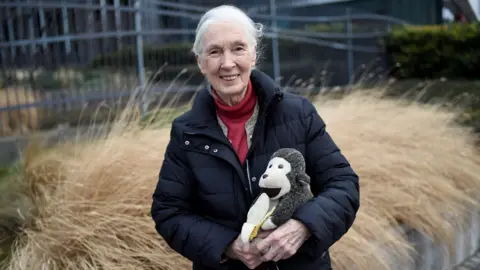 Getty Images
Getty ImagesWith her signature shawl draped over her shoulders and silver hair pulled back from her face, Jane Goodall exudes serenity – even over our slightly blurry video call.
In a Vienna hotel room, a press team and a small group of filmmakers, who are documenting her latest speaking tour, fuss around her.
The famous primatologist and conservationist settles into a high-backed chair that dwarfs her slender frame.
On my screen I can see that behind her, on a shelf, is her toy monkey, Mr H.
The toy was given to her nearly 30 years ago by a friend and has travelled the world with her. Dr Goodall is now 90 years of age, and she and Mr H are still travelling.
“I am a little bit exhausted,” she admits. “I’ve come here from Paris. And after here I go to Berlin, then Geneva. I’m on this tour talking about the danger to the environment and some of the remedies,” she says.
‘The sixth great extinction is happening now’
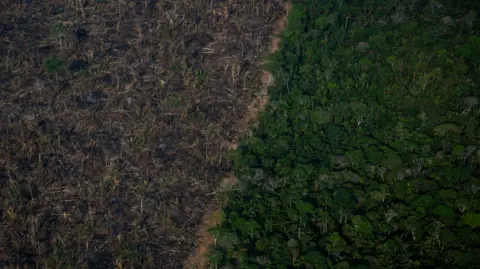 Getty Images
Getty ImagesOne of the remedies she wants to talk about today is a tree-planting and habitat restoration mission that her eponymous foundation and non-profit technology company, Ecosia, are carrying out in Uganda. Over the past five years, with the help of local communities and smallholder farmers, the organisations have planted nearly two million trees.
“We’re in the midst of the sixth great extinction,” Dr Goodall tells me during our interview for BBC Radio 4’s Inside Science. “The more we can do to restore nature and protect existing forests, the better.”
The primary aim of this project is to restore the threatened habitat of Uganda’s 5,000 chimpanzees. Dr Goodall has studied and campaigned to protect the primates for decades. But the activist also wants to highlight the threat that deforestation poses to our climate.
“Trees have to grow to a certain size before they can really do their work,” she says. “But all this [tree-planting] is helping to absorb carbon dioxide.”
‘Window of time to save climate is closing’
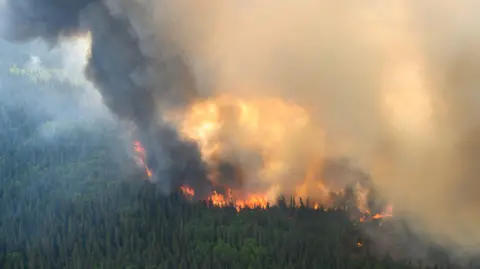 Reuters
ReutersThis week, world leaders have gathered in Baku, Azerbaijan, for COP29 – the latest round of UN climate talks.
And Dr Goodall says taking action to slow down the warming of our planet is more urgent than ever.
“We still have a window of time to start slowing down climate change and loss of biodiversity,” Dr Goodall says. “But it’s a window that’s closing.”
Destruction of forests, and other wild places, she points out, is intrinsically linked to the climate crisis.
“So much has changed in my lifetime,” she says, recalling that in the forests of Tanzania where she began studying chimps more than 60 years ago, “you used to be able to set your calendar by the timing of the two rainy seasons”.
“Now, sometimes it rains in the dry season, and sometimes it’s dry in the wet season. It means the trees are fruiting at the wrong time, which upsets the chimpanzees, and also the insects and the birds.”
Over the decades that she has studied and campaigned to protect the habitat of wild chimpanzees, she says she has seen the destruction of forests across Africa: “And I’ve seen the decrease in chimpanzee numbers.
“If we don’t get together and impose tough regulations on what people are able to do to the environment – if we don’t rapidly move away from fossil fuel, if we don’t put a stop to industrial farming, that’s destroying the environment and killing the soil, having a devastating effect on biodiversity – the future ultimately is doomed.”
‘He looked into my eyes and squeezed my fingers’
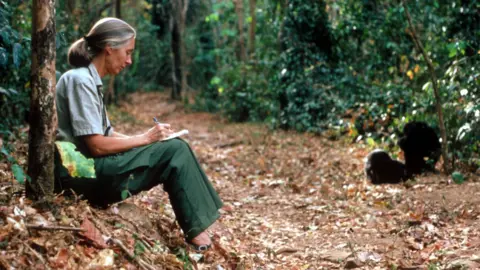 Getty Images
Getty ImagesHearing her speak in this way gives me a glimpse of a toughness that belies her well-spoken, gentle demeanour. When Jane Goodall began observing and studying chimpanzees in Gombe Stream National Park in Tanzania, she was a trailblazer. Her research, now considered groundbreaking, was controversial.
She was the first person to witness and document chimpanzees making and using tools – the primates prepared sticks to fish for termites. Prior to her observations, that was a trait that was thought to be uniquely human.
She revealed that the animals form strong family bonds – and even that they engage in warfare over territory.
But her approach – associating so closely with the animals she studied, naming them and even referring to them as “my friends” was scoffed at by some (mostly male) scientists.
Her supervisor and mentor, Professor Louis Leakey, though, saw the value in her technique: “He wanted somebody whose mind wasn’t messed up by the reductionist attitude of science to animals,” Dr Goodall explains.
“You don’t have a dog, a cat, a rabbit, a horse and not give them a name. It’s the same as when I studied squirrels in my garden as a little girl – they all had names.”
Her methods – and her sense of closeness to the primates she has dedicated her life to – have given her a unique perspective.
She tells me about a “wonderful moment” with a chimpanzee she named David Greybeard, the male chimp who she first witnessed making and using tools to catch termites. “He was the first to lose his fear of me,” she recalls.
“I sat down near him and, lying on the ground, was the ripe red fruit of an oil palm. I held it out towards him and he turned his head away. Then I put my hand closer and he turned and looked into my eyes, reached out and very gently squeezed my fingers.
“That is how chimpanzees reassure each other. We understood each other perfectly – with a gestural language that obviously predates human speech.”
‘We need to get tougher’
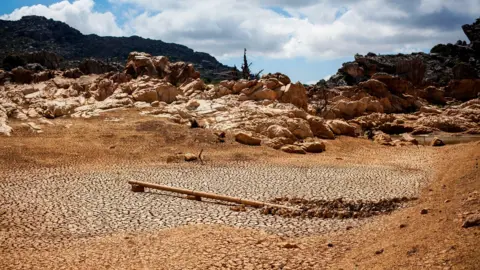 Getty Images
Getty ImagesDr Goodall’s career has often been challenging. She has written about the early years of her work for Professor Leakey, who was a renowned scientist, and who had enormous influence over her career. He repeatedly declared his love for her, putting pressure on her in a way that, today, might be viewed as sexual harassment.
But she spurned his advances and kept her focus on her work and her beloved chimpanzees. Now, having turned 90 this year, she does not appear to be slowing down.
So what keeps Dr Goodall going? On this she is emphatic – charmingly affronted by the question: “Surely people want a future for their children. If they do, we have to get tougher about [environmental] legislation.
“We don’t have much time left to start helping the environment. We’ve done so much to destroy it.”



